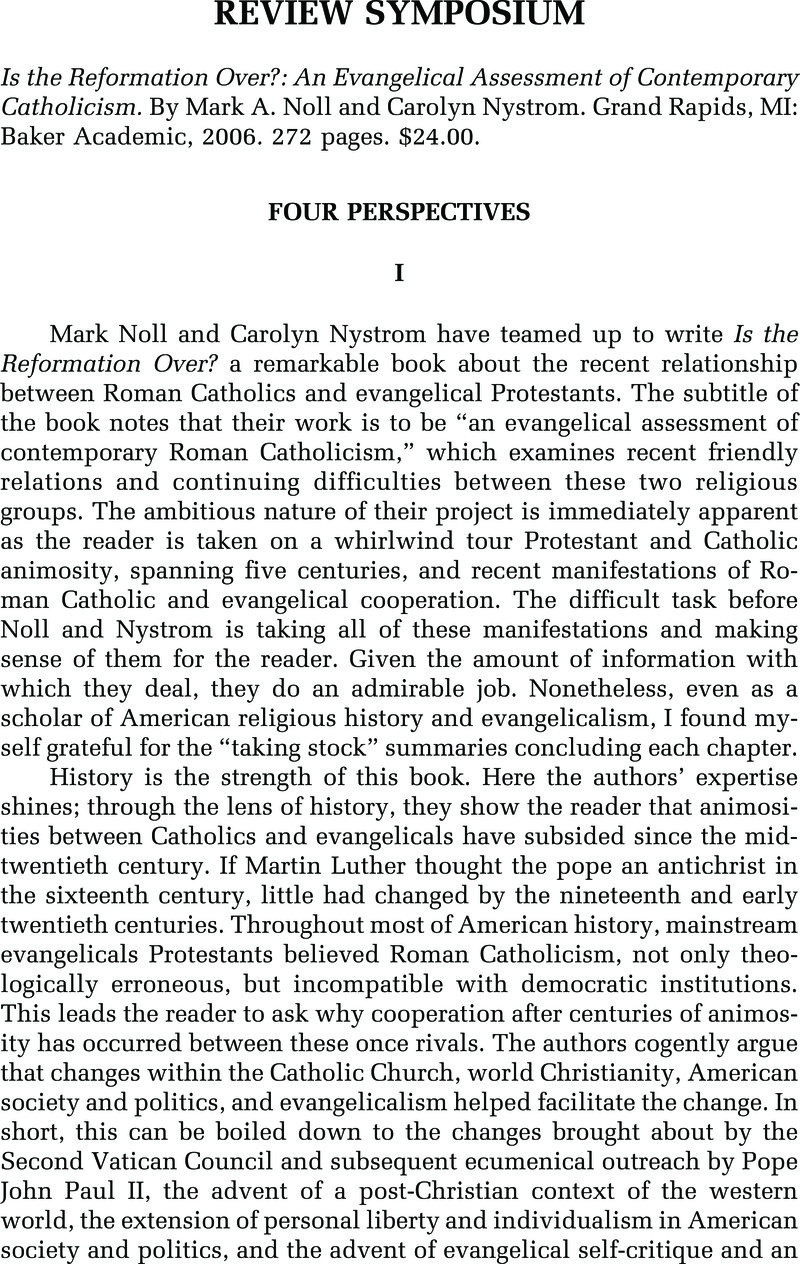No CrossRef data available.
Published online by Cambridge University Press: 18 March 2013

22 Neusner, Jacob, A Rabbi Talks With Jesus, rev. ed. (Montreal: McGill-Queen's University Press, 2000).Google Scholar
23 The Joint Declaration on the Doctrine of Justification (JDDJ, 1999) can be found on the Vatican and the Evangelical Lutheran Church in America websites. Michael Horton, professor of theology at Westminster Seminary in California, is one of the critics. See The Cambridge Declaration (1996), issued by the Alliance of Confessing Evangelicals in response to ECT (1993) and available at http://sites.silaspartners.com/CC_Content_Page/0,,PTID307086 CHID581262,00.html http://sites.silaspartners.com/CC_Content_Page/0,,PTID307086 CHID581262,00.html (accessed 4 October 2007). This latter declaration reflects traditional conservative Protestantism in its rejection of the Roman Catholic Church as a legitimate church. This is due mainly to the differences expressed over the issue of justification.
24 See, e.g., The New Catholics: Contemporary Converts Tell Their Stories, ed. O'Neill, Dan (NY: Crossroad, 1987)Google Scholar and Currie, David, Born Fundamentalist: Born Again Catholic (San Francisco: Ignatius Press, 1996).Google Scholar
25 Forensic justification is as odd and alien to Catholics as Marian doctrines and practice are to evangelicals. Catholics and reformed evangelicals simply do not talk about the matter in the same way. That is not going to change, except by conversion of one side to the other., official declarations such as the JDDJ not withstanding.
26 For my own view of the status of such ecclesiological claims see Shea, William M., The Lion and the Lamb: Evangelicals and Catholics in America (New York: Oxford University Press, 2004)CrossRefGoogle Scholar, under “Myth” in the first chapter, and the last chapter passim.
27 Paul, Pope John II, Encyclical Ut Unum Sint (Vatican City: Liberia Editrice Vaticana/Washington, DC: United States Catholic Conference. 1995).Google Scholar The English language translation can be found in The Encyclicals of John Paul II, ed. Miller, J. Michael (Huntingdon, IN: Our Sunday Visitor Publishing Co., 1996), 914–76Google Scholar; see esp. par. 88 ff.
28 Congregation for the Doctrine of the Faith, “Responses to Some Questions Regarding Certain Aspects of the Doctrine on the Church” (29 June 2007), http://www.vatican.va/roman_curia/congregations/cfaith/ documents/rc_con_cfaith_doc_ 20070629_responsa-quaestiones_en.htmlGoogle Scholar (accessed 3 October 2007).
29 I take the Western councils up to Vatican II to be local synods, none of whose doctrines and dogmas are binding on the oecumene.
30 Bloom, Harold, The American Religion: the Emergence of the Post-Christian Nation (New York: Simon and Schuster, 1992).Google Scholar Examples of the reawakening of classic Gnosticism in a host of new forms include Theosophy, New Thought, Christian Science, Mormonism, Mind Cure, New Age, aspects of the early Christian studies movement, and the Jesus seminar. For a remarkable presentation by one of the leaders, see Elaine Pagels' lecture to the members of the Seminar, Jesus, “Let there be Light: Does the Divine shine through Jesus alone or in everyone?” (Spring, 2002), available in DVD at www.insightmedia.comGoogle Scholar (accessed 2 October 2007).
31 Jenkins, Philip, Mystics and Messiahs: Cults and New Religions in American History (New York: Oxford University Press, 2000)Google Scholar; idem, Hidden Gospels: How the Search for Jesus Lost its Way (New York: Oxford University Press, 2001); idem, Dream Catchers: How Mainstream America Discovered Native Spirituality (New York: Oxford University Press, 2004).
32 Pagels, Elaine, Beyond Belief: The Secret Gospel of Thomas (New York: Random House, 2003)Google Scholar; King, Karen, What is Gnosticism? (Cambridge, MA: Belknap/Harvard University Press, 2003).Google Scholar
33 E.g., by Sam Harris, Michael Shermer, Daniel Dennett, David Eller, and Richard Dawkins.